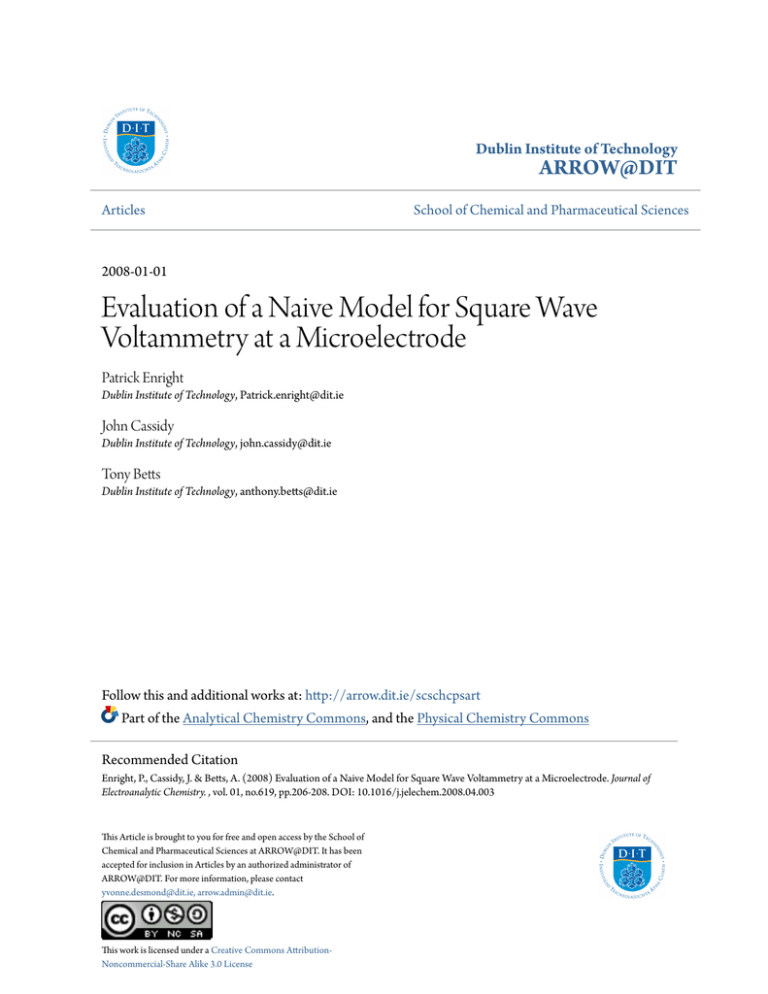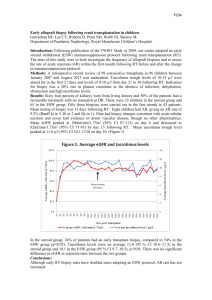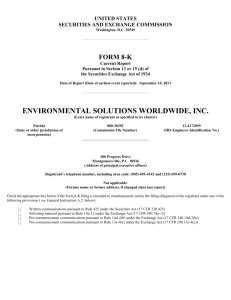Evaluation of a Naive Model for Square Wave
advertisement

Dublin Institute of Technology ARROW@DIT Articles School of Chemical and Pharmaceutical Sciences 2008-01-01 Evaluation of a Naive Model for Square Wave Voltammetry at a Microelectrode Patrick Enright Dublin Institute of Technology, Patrick.enright@dit.ie John Cassidy Dublin Institute of Technology, john.cassidy@dit.ie Tony Betts Dublin Institute of Technology, anthony.betts@dit.ie Follow this and additional works at: http://arrow.dit.ie/scschcpsart Part of the Analytical Chemistry Commons, and the Physical Chemistry Commons Recommended Citation Enright, P., Cassidy, J. & Betts, A. (2008) Evaluation of a Naive Model for Square Wave Voltammetry at a Microelectrode. Journal of Electroanalytic Chemistry. , vol. 01, no.619, pp.206-208. DOI: 10.1016/j.jelechem.2008.04.003 This Article is brought to you for free and open access by the School of Chemical and Pharmaceutical Sciences at ARROW@DIT. It has been accepted for inclusion in Articles by an authorized administrator of ARROW@DIT. For more information, please contact yvonne.desmond@dit.ie, arrow.admin@dit.ie. This work is licensed under a Creative Commons AttributionNoncommercial-Share Alike 3.0 License Evaluation of a Naive Model for Square Wave Voltammetry at a Disk Microelectrode. Patrick Enright 1,2, John Cassidy1, * Anthony Betts3, 1 School of Chemical and Pharmaceutical Sciences, Dublin Institute of Technology, Kevin Street , Dublin 8, Ireland. 2 FOCAS, Dublin Institute of Technology, Kevin Street, Dublin 8, Ireland 3 DRE, Dublin Institute of Technology, 143-149 Rathmines Road, Dublin 6, Ireland * Corresponding Author. Abstract A square wave voltammetric waveform ( SWV) was applied to an inlaid microdisk electrode in a solution of K4[Fe(CN)6]. A simple model relying on the assumption of steady state current throughout the scan was used to model the current potential behaviour. However, experimental peak current magnitudes were between 30% and 50% greater than those predicted by the model. The model predicts an increase of peak current and peak width at half height with pulse height Esw and no effect of the parameters frequency, f and step height, ∆Es. Experimental peak current magnitudes and peak current magnitudes predicted by the model both increased with increasing Esw but were not affected by f or ∆Es. Keywords: microelectrode, square wave voltammetry. 1. Introduction Microelectrode have found many uses in electroanalysis as single disks or arrays. The use of square wave voltammetry ( SWV) has traditionally been employed for anodic stripping methods, for example in the determination of epinephrine[1] and more commonly for the detection of heavy metals, Cd2+, Pb2+ and Cu2+[2-4]. However organics such as paraquat[5,6], chloroamphenicol[7] and vanillin[8] have been determined using SWV at microelectrodes. There has been work done in modelling SWV at microelectrodes by Whelan et al [9]. Furthermore the application of SWV has been modelled at spherical electrodes[10] and spherical microelectrodes[11]. In this short communication, we evaluate the application of and empirical model, used previously for differential pulse voltammetry at a microelectrode [12] and a rotating disk electrode [13], to SWV at a microelectrode disk. 2. The steady state model This model relies on the rapid achievement of a microelectrode steady state current on application of SWV pulses. The square wave voltammetric waveform arises from the superimposition of two waveforms, an incremental staircase potential of amplitude ∆Es, which has a square wave amplitude waveform superimposed on it of magnitude Esw[14,15]. The current is sampled at the lower potential of the Esw, at tp, and then at the higher potential, at 2tp where tp is related to the frequency of the square wave waveform, as f = 1/(2tp), and the difference between these two currents is output. The pulse of length tp corresponds to half the period of the applied staircase potential. At the lower potential the current is given by i1 = 4nFrDC 1 + ε1 (1) where r is the microelectrode radius, D the diffusion coefficient of the electroactive species in solution, C its concentration and ε1 is a function of the applied potential Ei: − nF(E i − E o ) ε 1 = exp RT (2) Ei is the initial potential and Eo is the formal potential of the electroactive couple. On application of the pulse Esw, the current sampled is i2 = 4nFrDC 1+ ε2 (3) where − nF(E i + 2Esw − E 0 ) RT ε 2 = exp (4) And in the next time increment the base potential Ei will increment by ∆Es. The output current is δi = i2 - i1. (5) Typically the current output is plotted against the mid point potential of each square wave cycle[9]. As an approximation, the Taylor series expansion of the exponential function is given by: 1 x 1+ e 3 4 ≈ 1 / 2 − x/4 + x / 48 + O(x ) and this may be used to obtain an estimate for δi. (6) 3. Experimental Experiments were carried out at room temperature ( 20 ± 3oC) using a microelectrode, with a nominal 10 µm or 25µm diameter Pt disk ( source = IJ Cambria Scientific Ltd, 11 Gwscwm Road, Burry Port , Carms, SA16 OBS UK ) in a three electrode one compartment cell. The reference electrode was a saturated calomel electrode and the auxiliary electrode was Pt wire. Potentials were controlled using a CHI 620A Electrochemical Analyser. Chemicals were reagent grade and solutions were prepared in deionised water. 4. Results and Discussion From initial linear sweep voltammetric experiments with the two electrodes in 5 mM K4[Fe(CN)6] in 0.1 M KCl, the current was determined to be 5.1 nA and 14.1 nA from which effective radii were calculated to be 4.1 microns and 11.2 microns respectively, using a diffusion coefficient of 6.5 x 10-6 cm2s-1[16]. Following this, square wave potential waveforms were applied to determine the nature of the current response. The parameters varied for the SWV were the pulse height Esw, the step height ∆Es and the frequency. The parameter which has the greatest effect on the peak current is the pulse height Esw. Figure 1 shows the experimental current profile for a range of Esw values. It can be seen that the peak current and the peak width at half height increases with Esw. The peak current magnitude varies linearly with the Esw up to and Esw value approximately 50mV ( Y = 104 X + 0.27, R2 = 0.98, Y is in nA and X is in V). At higher Esw values, the magnitude of the peak current levels off with increasing Esw. When (6) is substituted into (5) the approximation is δi ≈ 2 n2F2rDCEsw/(RT) (7) which predicts a linear behaviour between the peak current and Esw. From an analytical viewpoint, changing Esw will increase the sensitivity of the analytical method. Figure 2 shows the modelled profile predicted by model for the experimental conditions of Figure 1. It can be seen that the current potential profile of Figure 2 mirrors that of Figure 1. Table 1 displays the characteristic parameters of the profiles. It can be seen that there is an increase in δip with Esw. The notable difference between the model and experimental results is the peak current magnitude. At low Esw values the difference between theory and experimental is relatively constant. This difference cannot be explained by double layer charging current or residual current since there is not enough residual current in the experimental plots to warrant this assertion. The greater experimental current may be due to a redox cycling effect where the [Fe(CN)]3- generated on the forward pulse is reduced on the subsequent reverse pulse and vice versa. The difference is consistent at low Esw values for both electrodes. At higher Esw values the percent difference increases as the pulses are larger which means that the currents are deviating from steady state and the current is being sampled during a Cottrell regime. Changing ∆Es from 4 to 15 mV at the 4.1 µm radius microelectrode yielded a peak current of 1.3 nA. The model also predicts no effect of ∆Es on peak current magnitude. Similarly at low frequencies (f<15Hz), the frequency has no effect on the peak current magnitude; which is also predicted by the model. 5. Conclusion This simple model predicts that there is an increase in sensitivity with increasing pulse amplitude, Esw. This is borne out with experimental results. In addition there is no increase in sensitivity with step height, ∆Es or frequency. In addition there is no shift in the peak current position with all three of these parameters. However there is a large discrepancy between the experimental and modelled current. 6. Acknowledgement JC acknowledges a Team Research Grant from the DIT, 7 References 1. S.-Y Ly, Y.-H. Kim, I.-K.Han, I.-G.Moon, W.-W.Jung, S.-Y.Jung, H.-J.Sin, T.-K. Hong, M.-H.Kim, Microchemical Journal, 82, 2006, 113. 2. P.R.M.Silva, M.A.El Khakani, M.Chaker, A.Dufresne, F.Courchesne, Sensors and Actuators B, Chemical,76, 2001, 250. 3. P.R.M.Silva, M.A.El Khakani, B.Le Drogoff, M.Chaker, A.K.Vijh, Sensors and Actuators B, Chemical, 60, 1999, 161. 4. P.R.M.Silva, M.A.El Khakani, M.Chaker, G.Y.Champagne, J.Chevalet, L.Gastonguay, R. Lacasse, M.Ladouceur, Analytica Chimica Acta, 385, 1999, 249. 5. D.De Sousa, S.A.S.Machado, R.C.Pires, Talanta, 69, 2006, 1200. 6. D.De Sousa, S.A.S.Machado, Analytica Chimica Acta, 546, 2005, 85. 7. L.Agüí, A.Guzmán, P.Yánez-Sedeno, J.M.Pingarrón, Analytica Chimica Acta, 461, 2002, 65. 8. L.Agüí, J.E.López-Guzmán, A.González-Cortés, P.Yánez-Sedeno, J.M.Pingarrón, Analytica Chimica Acta, 385, 1999, 241. 9. D.P.Whelan, J.J.O’Dea, J.Osteryoung, K.Aoki, J.Electroanal. Chem, 202, 1986, 23. 10. A Molina, C.Serna, F.Martínez-Ortez, J.Electroanal. Chem., 486, 2000, 9. 11 F.Garay, M.Lovrič. J.Electroanal Chem, 527, 2002, 85. 12 E. Howard, J.Cassidy, J.O’Gorman, Electroanalysis, 10, 1998, 1208. 13 E. Howard, J.O'Gorman, J.Cassidy, Electroanalysis, 11, 1999, 23. 14. J.Osteryoung, J.J.O’Dea, in A.J.Bard, ed. Electroanal Chem. Vol 14, M.Dekker, Ney York, 1986, 209. 15. J.Osteryoung, in M.I.Montenegro et al. (eds.) Microelectrodes, Theory and Applications, Kluwer, Dordrecht, 1991, 139. 16. D.T.Sawyer , J.L Roberts, Experimental Electrochemistry for Chemists, Wiley, New York, 1974, p.77. Figure legends Figure 1 Experimental output for SWV at a 4.1 micron radius Pt microelectrode. ∆Es = 4 mV, K4[Fe(CN)6] = 5 mM in 0.1M KCl, f = 5 Hz and the values of Esw are 5, 15, 25, 35, 45, 60 and 80mV in order of increasing current magnitude.. Figure 2. Simulated output using the Model for SWV at a 4.1 micron radius microelectrode. Esw = 5, 15, 25, 35, 45, 60 and 80 mV. Other conditions are as in Figure 1. Table 1. Experimental and model I simulation outputs. f = 5Hz, ∆Es = 0.004 V and C = 5 mM. The δi% difference is the calculated as 100( experimental – theory)/theory Model Experimental Ep/ V δip/ nA Ep/V δip /nA δi% 15 0.179 1.48 0.176 2.00 34 4.1 25 0.181 2.36 0.176 3.11 32 4.1 35 0.179 3.08 0.176 4.17 35 4.1 45 0.181 3.66 0.180 4.96 35 4.1 60 0.180 4.27 0.180 6.09 32 11.2 5 0.181 1.39 0.180 1.99 44 11.2 10 0.178 2.80 0.184 3.97 44 11.2 15 0.179 4.06 0.184 5.92 46 11.2 20 0.180 5.31 0.184 8.20 54 11.2 25 0.181 6.45 0.184 10.10 56 11.2 35 0.179 8.45 0.184 13.34 54 11.2 45 0.181 10.03 0.184 16.93 69 11.2 60 0.180 11.69 0.188 20.13 72 Electrode Esw Radius µm /mV 4.1



